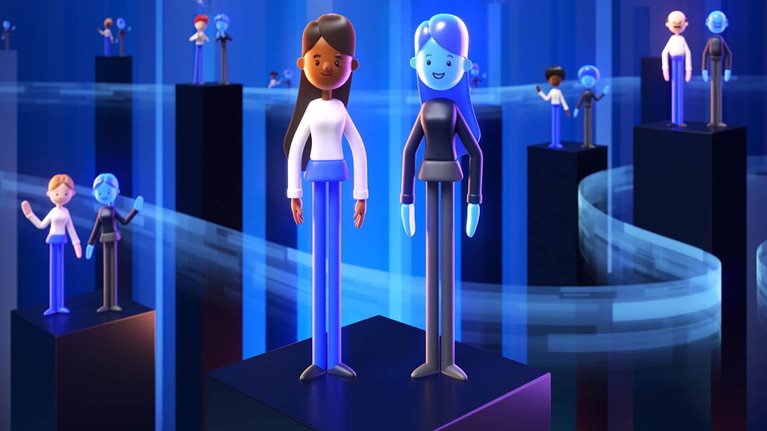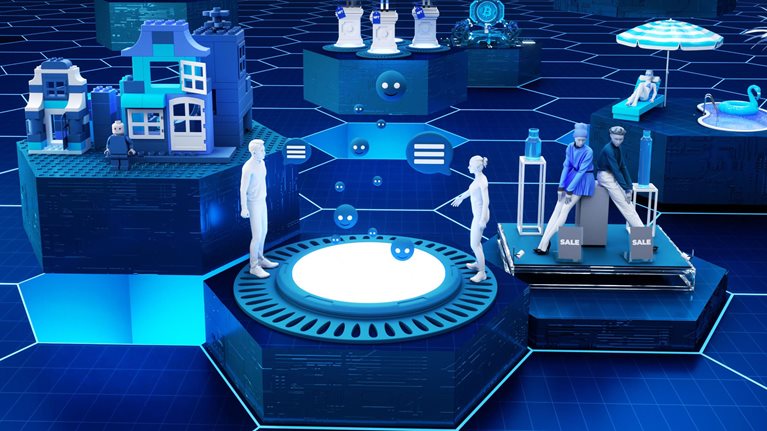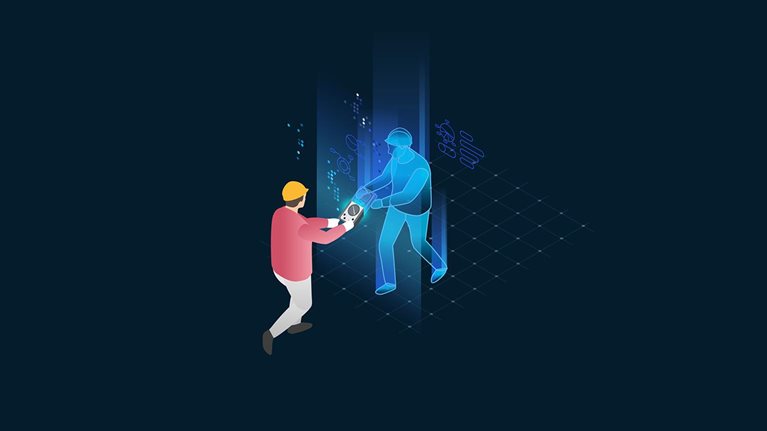Riding in a car is a very physical experience, from gripping the steering wheel to pressing down the gas pedal to feeling a jolt if the vehicle suddenly stops. One day, people may experience these same sensations by taking a virtual ride in the metaverse—the next iteration of the internet in which people can immerse themselves in a digital world that closely mimics reality.
The full-fledged metaverse will likely require at least five to ten years to materialize, but stakeholders in the mobility sector can already capture real business value from the “proto-metaverse.” This early incarnation relies on spatial computing and extended reality (XR), which is an umbrella term that includes augmented reality (AR), virtual reality (VR), and mixed reality (MR). The proto-metaverse has already enhanced both sales and operations within the mobility sector, and many leading OEMs and other stakeholders are launching metaverse initiatives to explore their benefits to the core business.
This article examines how selected technologies, available today or in the near future, can help expand and diversify revenue streams in the mobility sector, enhance brand loyalty, improve customer experience, and optimize production. (For a more comprehensive look at current and future technologies, see sidebar “Mobility moves toward the metaverse.”) Going forward, could OEMs increase brand awareness with applications that let potential car buyers participate in highly realistic virtual races at Le Mans? Or could technicians walk customers through easy repairs at home using virtual twins of engines? Such experiences could be possible if the metaverse continues to advance. But even before the advent of such immersive experiences, OEMs still have much to gain from metaverse tools and concepts.
Kicking virtual tires: Customers in the metaverse
In a recent McKinsey consumer survey, 59 percent of respondents say that they prefer to conduct at least one daily activity, such as socializing, shopping, fitness, or education, in the virtual world rather than in person.1 Another survey also indicates that excitement about the future metaverse is consistently high across demographic groups, regardless of region, age, or gender.2
These findings bode well for greater use of metaverse-related experiences and technologies over the next few years, as do other recent developments. For instance, the market value of XR devices is expected to increase nearly tenfold, from $28 billion in 2021 to more than $250 billion in 2028.3
The metaverse showroom: Just a click away
Many potential car buyers now research vehicles online before buying, which partly explains why US consumers in 2017 visited only two dealerships before making a purchase, down from five in 2007.4 The pandemic has reduced the odds that potential buyers will find their vehicle of choice on the lot, however, because of supply chain disruptions. OEMs may partly compensate for the lack of inventory by using immersive virtual experiences to help potential buyers envision and configure their desired vehicles.
These new technologies go far beyond websites that allow users to click on different vehicle features to get information or cycle through custom options. RelayCars, for example, offers a mobile application with AR and 3-D visuals that allow users to explore thousands of cars. But even with more sophisticated online tools, the average car buyer will still want to see an actual car before making a purchase, since even the best online images may not provide the clarity and detail that a car buyer needs.
Beyond sales, a few OEMs are creating digital worlds designed to engage the brand community, rather than delivering anything close to the actual driving and buying experience. For instance, Acura has opened a virtual showroom in Decentraland, a virtual-reality platform, to introduce customers to its 2023 Integra model. Potential car buyers can walk through the dealership and engage in interactive experiences, including racing cars virtually. The first 500 customers who reserved a 2023 Acura Integra also had the opportunity to receive a nonfungible token (NFT) of the vehicle. Similarly, Skoda has created an experience called Skodaverse, which allows users to take test drives resembling those in a video game or visit their NFT gallery, which has various commissioned artworks.
Would you like to learn more about the McKinsey Center for Future Mobility?
Mobility players have also started to create avatars to serve as virtual salespeople, influencers, or brand ambassadors. Porsche, for instance, has used virtual brand ambassadors in China to attract younger customers.5
Creating the future metaverse experience. These early attempts to link the virtual and physical worlds may evolve into more immersive experiences. Improvements in XR, combined with the advent of haptic devices that simulate a touching sensation, could allow consumers to examine a highly realistic replica of a vehicle—opening its doors, feeling its seats, accelerating onto a highway—just as they would with a real car.
Initially, advanced virtual shopping experiences are likely to occur at dealerships or trade shows rather than in customers’ homes because OEMs are more likely to purchase the expensive devices required to enable this kind of immersive virtual world (Exhibit 1). As consumer adoption of XR devices increases, however, virtual experiences could be more readily available in people’s homes. If even more advanced body sensors and other technologies emerge, customers might be able to undertake highly realistic test drives in which they simulate multiple activities, including merging into traffic or backing into their own garage.

For marketing, OEMs may be able to enhance consumer engagement by creating truly unique customer experiences6 that would not be possible in real life—for example, hosting a launch event in a virtual forest to highlight the usage of sustainable materials or allowing consumers to race their new cars virtually to highlight the heritage of a sports car brand. (For more on the advantages of using these tools, see sidebar “Marketing and sales benefits from the metaverse.”)
The car as home theater: Better infotainment, entertainment, and driver assistance options
A few OEMs have already created or plan to launch driver assistance applications that rely on metaverse tools. Most new Mercedes-Benz models, for example, offer heads-up-display technology, which shows digital information on a car’s windshield, such as speed, GPS directions, cruise control settings, and current traffic conditions.7 The technology company HERE, working in conjunction with Unity Technologies, is creating a dashboard screen that includes a 3-D map of a vehicle’s surrounding area. Drivers can see where they are on the screen; as the vehicle moves, information and alerts about the surrounding area, such as nearby businesses, pop up to notify the driver.
New infotainment packages are also emerging (Exhibit 2). The company holoride, founded in 2018, is creating hyperimmersive experiences for riders. One of its packages, available now to Audi customers, includes a VR headset and a game that allows passengers to move through a 3-D-landscape.8 The motion in the game matches that of the vehicle—for instance, virtual objects approach much more quickly when the car speeds up.

Future applications. More advanced driver assistance systems using AR may soon be available that increase safety by providing additional data, such as information about upcoming road hazards or pedestrian traffic.
The metaverse could also enable new and better entertainment options as technologies advance. WayRay’s Holograktor, an upcoming vehicle for the ride-hailing market, is being designed to have metaverse-related applications for both driver assistance and entertainment.9 The vehicle will use sensors and cameras to process data and project AR holograms on various vehicle windows, displaying information about nearby points of interest such as restaurant offers or sales at stores. The technology will also allow passengers to use the AR holograms to play video games.
New infotainment opportunities could transform how people spend their time in cars, especially if autonomous vehicles gain ground. Imagine parents who need to commute to work and transport their children to school via ridesharing or robo shuttle services. While in transit, the child could engage with immersive educational applications while the parents plan dinner for the evening. Or, during downtime in traffic jams, riders in autonomous vehicles could use VR devices to be more present in virtual meeting rooms. McKinsey research suggests that in-car entertainment could generate between $30 billion and $60 billion in value by 2030.
Virtual vehicles, real solutions: The metaverse in manufacturing and maintenance
Beyond enhancing sales and the customer experience, the metaverse is already enabling OEMs to improve vehicle design, production, and servicing.
Back to the drawing board: Virtual vehicle design
Traditional automotive design typically starts with 2-D sketches of a vehicle. OEMs then use computer-aided design software to create high-quality 3-D models based on the original sketches. In a departure from this process, some OEMs are attempting to streamline design and reduce quality issues with XR tools. For instance, designers at Ford are experimenting with Gravity Sketch, a tool that creates 3-D renderings of vehicles that are viewable with headsets.
Hyundai has also transformed its design process, which used to take between four weeks and two months, with 3-D-design software and AR tools that facilitate collaboration. Once designers are satisfied with their initial designs, they create a clay model and begin working on the vehicle’s interior.10 Wearing special VR visors, designers can also see vehicles in different settings, ranging from a desert to a wet road.
In addition to designing cars online, companies are using virtual worlds for enhanced vehicle testing. Nvidia’s DRIVE Sim platform evaluates autonomous vehicles by generating simulations of different environments—such as highways or crowded urban roads—that test the vehicle’s perception systems, decision-making capabilities, and control logic. Among other benefits, the platform reduces testing costs and allows Nvidia to investigate the performance of autonomous vehicles in more diverse environments and situations that might be difficult to replicate and assess in real life.

Value creation in the metaverse
Future metaverse applications. Aligning stakeholders on vehicle aesthetics, aerodynamics, and other features, such as materials, is not always easy, but immersive virtual environments could help teams resolve conflicts about product requirements, output, and other issues by allowing them to experiment rapidly with virtual models, exactly as they would with real materials and models. They could study how light would reflect off a mirror, experience a vehicle’s interior acoustics, or see what the chassis would look like before one is built.
The future metaverse might also allow OEMs to involve car buyers more closely in the vehicle development process by holding events that allow customers to examine virtual models. This could reduce timelines for vehicle production, as well as decrease budgets invested in focus groups, including those related to vehicle and participant transport.11 In addition to informing design choices about models under development, such technologies could provide OEMs with continuous feedback that informs later R&D efforts. For example, engineers could create a digital twin of a car—a realistic virtual representation—to track the car’s performance and collect real-time data, which could allow them to make tailored product updates for specific vehicles.
Although transformations in digital product development may require an investment in the hundreds of millions, we estimate that companies might achieve a 10 to 12 percent EBIT uplift and a decrease of up to 50 percent in time to market.
Virtual factory, real insights: Digital twins and more
OEMs are already using digital twins of factories and their production lines to improve vehicle manufacturing. BMW, for instance, is using Nvidia’s Omniverse platform to plan a new factory in which people and robots work closely together and engineers collaborate in a shared virtual space.12 The platform integrates information from various design and planning tools to generate extremely realistic images of the planned factory. The goal is to allow BMW to create complex production systems more quickly and accurately.
Beyond optimizing a factory layout and processes, digital twins can help OEMs accelerate the launch of new assembly lines and provide guidance for factory-based technicians. They also can provide full visibility into software, hardware, manufacturing, and maintenance interdependencies. Our models suggest that digital twins can potentially improve output by about 10 to 25 percent while reducing unplanned maintenance by 80 percent and increasing quality by up to 25 percent.
In the future, digital twins will likely be even more realistic—for example, all engines and machines within a plant could be fully connected in the digital twin, sharing detailed performance information in real time.
Repair and maintenance
OEMs can use metaverse tools to train automobile technicians and guide them through the repair process for a vehicle. Daimler Trucks North America, for example, recently experimented with a pilot to use AR technology at its dealerships to provide step-by-step training and guidance for service technicians.13 Similarly, wearable XR devices are currently being used in every BMW dealership in the United States. The metaverse can also help OEMs expand their service networks by making it easier to train and license third-party technicians in distant locations, as well as allow OEMS to better engage with customers throughout the life cycle of a vehicle. This capability may become even more critical in the future since talented technicians are in increasingly short supply.
As technologies evolve, cars may collect and provide more information during the vehicle life cycle. Technicians could use these new tools to inspect a vehicle’s onboard data and then connect virtually with an AI-based avatar for joint diagnosis. If an issue appears to have a relatively easy fix, OEMs might connect to customers directly and walk them through the repair process at home. In other cases, OEMs could direct customers to a third party for repairs. Our research indicates that using virtual technologies in servicing could increase revenues by 5 to 10 percent.

OEMs and other mobility players can already generate substantial value today by adopting the metaverse, even if it delivers only a share of the full experience expected in the future. To create the greatest impact, companies can consider aligning on their business goals for metaverse applications while simultaneously considering future use cases, including essential skills and requirements for the underlying complex ecosystem. Some of the changes ahead may not be entirely positive—for instance, the metaverse could decrease travel, especially for business—but the potential opportunities could more than compensate for such drawbacks.



